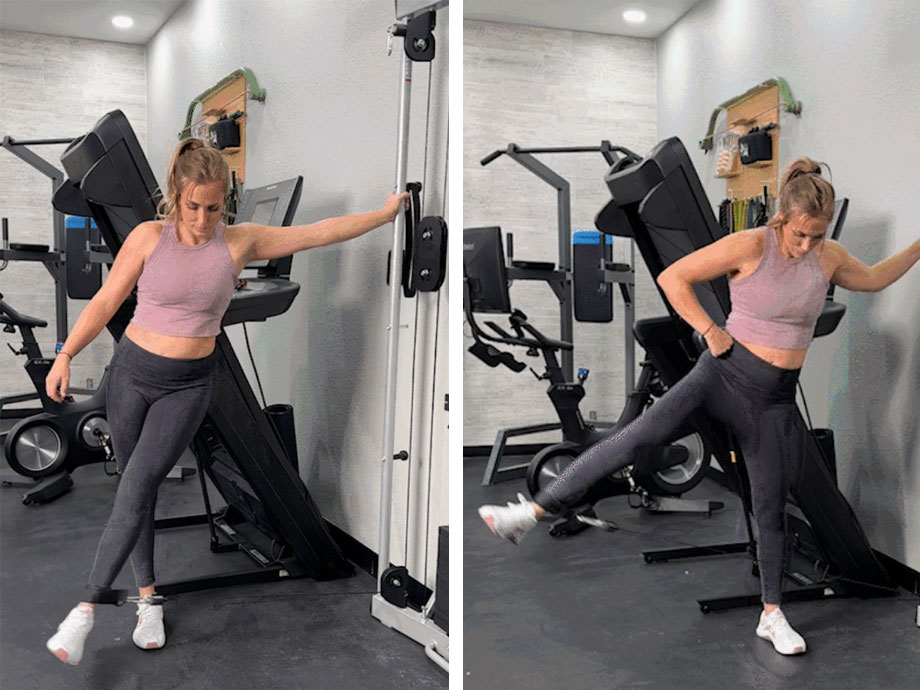We test and review fitness products based on an independent, multi-point methodology. If you use our links to purchase something, we may earn a commission. Read our disclosures.
Adduction and abduction sound and look similar, don’t they? There’s only a one-letter difference between the two, but when it comes to the types of movement and range of motion each one is responsible for, they’re complete opposites. Adduction is where a body part (usually your hips) moves toward the body’s midline, whereas abduction is movement away from the centerline.
I’m a certified personal trainer (CPT) and well-versed in teaching the difference to clients. I’ll begin this guide by breaking down the two terms. I’ll then give five exercises to hit your adductor muscles and five to target your abductor muscles. Next, you’ll see a beginner-friendly workout routine you can try, and to finish, I’ll describe the benefits of adduction vs abduction.
Examples Of Adduction vs Abduction
Before I get into the nitty-gritty, here’s a chart that highlights—at a high level—the differences between these anatomical positions:
| Adduction | Abduction | |
| Movement | Toward the midline of the body (anterior) | Away from the midline of the body (posterior) |
| Muscles involved | – Adductor magnus- Adductor longus- Adductor brevis- Gracilis- Pectineus | – Gluteus medius- Gluteus minimus- Tensor fasciae latae |
| Example exercises | – Standing banded adduction- Side-lying adduction- Wide stance squat- Lateral lunges- Copenhagen hip adduction | – Standing banded abduction- Side-lying abduction- Clamshells- Fire hydrants- Banded lateral walks |
It’s important to note that the above muscles and exercises only refer to abduction and adduction around the hip joint. You get upper limb adduction and abduction when your arms move toward or away from your body’s midline (using your deltoids, lats, and pecs). Still, the terms abduction and adduction—in the fitness scene—usually refer to your lower body and don’t involve flexion and extension.
What Is Adduction?
As you saw above, adduction occurs when your hips move toward your body’s midline. This movement involves the adductor group of thigh muscles1, which includes:
- Adductor magnus
- Adductor longus
- Adductor brevis
- Gracilis
- Pectineus
As well as adducting the thigh, the above muscles stabilize the pelvis, helping to maintain its balance during walking.

How To Target Your Adductor Muscles
There are several fantastic adductor exercises to hit your adductor muscles:
- Standing banded adduction: Loop one end of a resistance band around a door or squat rack and the other around your ankle. Position your leg to the side and then move it into the center. To increase the difficulty, step away from the anchor point.
- Side-lying adduction: Beginners or those new to resistance training may want to try the side-lying adduction exercise. Lie on the floor on one side, ensuring that both legs are straight. Bend your top leg and cross it over your bottom leg. Then, raise your bottom leg toward the ceiling.
- Wide-stance squat: Because of the wider stance, you’ll work your adductor muscles to a greater extent than regular back squats. At the same time, you’ll still hit your quads, hamstrings, glutes, and calves.
- Lateral lunges: As you step laterally and lunge, you contract your adductors. You don’t get the same result when you use many of the other lunge alternatives, like forward or reverse, which is why lateral lunges are more effective at targeting the adductors.
- Copenhagen hip adduction: A 2019 BMJ Open Sport & Exercise Medicine2 study found that this exercise increases eccentric hip adduction strength while preventing excessive muscle soreness. It’s similar to a side plank, but instead of both feet being on the floor, your top foot is on a bench. You then slowly bring your bottom leg up towards your top leg.

What Is Abduction?
Abduction is the opposite of adduction—it takes place when your hips move away from the midline of your body. The main three hip abductor muscles3 are the following:
- Gluteus medius
- Gluteus minimus
- Tensor fasciae latae
The hip abductor muscles are also responsible for maintaining your pelvic stability.

How To Target Your Abductor Muscles
Here are five great abduction exercises to target your abductor muscles:
- Standing banded abduction: Like the standing banded adduction above, loop one end of a resistance band around a door or squat rack and the other around your ankle. Position your leg at the centerline and slowly move it to the side.
- Side-lying abduction: Lie on the floor on your left side. Your top leg (right leg) should be straight, with your bottom leg (left leg) bent underneath. Lift your right leg toward the ceiling and hold for a few seconds. When finished, you’ll then repeat the movement on your right side.
- Clamshells: Begin on the floor or an exercise mat. Your hip and forearm on one side of your body should be on the floor, your legs bent at a 90-degree angle, and your feet together. Now, lift the top knee as high as possible. A 2014 Clinical Biomechanics4 study found that clamshells may be a great “rehabilitative exercise to prescribe when minimal tensor fasciae latae muscle activation is desired.”
- Fire hydrants: In the starting position, get down on all fours with your hands shoulder-width apart. Your knees should be directly underneath your hips, and your hands beneath your shoulders. Lift one knee to the side (laterally), lower it down, and then lift the opposite knee.
- Banded lateral walks: Place a resistance band around your quads and bend your knees slightly. Step to one side for the desired distance or number of reps, then pause and reverse your direction.

Adduction vs Abduction: Workout Routine
Now that you understand the difference between adduction and abduction, here’s a beginner-friendly workout routine I recommend to clients who want to train their lower-body muscle groups with both movement patterns:
| Exercise | Sets | Reps |
| Wide-stance squat | 3 | 8 |
| Banded lateral walk | 3 | 10, each side |
| Lateral lunge | 2 | 10, each side |
| Fire hydrant | 2 | 12, each side |
| Standing banded adduction | 2 | 15 |
| Standing banded abduction | 2 | 15 |
There are 14 sets in total, which is more than sufficient to work your hip abductors and hip adductors. If bodyweight wide stance squats are too easy, add resistance by holding a dumbbell or kettlebell. You can also use a resistance band for lateral lunges and fire hydrants if either exercise isn’t challenging enough.
You’ll want to rest for roughly one minute between sets, although you may need less than this on the latter exercises, which are less intense than the former. Before you do this adduction vs abduction workout routine, warm up with light cardio and lower-body warm-up exercises such as leg swings, hip circles, high knees, or jumping jacks.

What Are the Benefits Of Understanding Abduction vs Adduction?
Why do you need to know about adduction vs abduction in the first place? First of all, knowledge is power. But if that isn’t enough to convince you, this list of benefits might:
Helps Improve Your Athletic Performance
When you do compound exercises such as squats and deadlifts, you use your adductors5. Improving your lifts may become difficult if your adductors are weak. On the other hand, your abductors are important in sports that require lateral movement or jumps, such as tennis or basketball. Strengthening your inner thighs and outer thighs can help elevate your athletic performance.
Helps Prevent Injuries
Weak abductors or adductors may also lead to injury, especially in your knees, hips, and groin. This is especially true if you have strong abductors and weak adductors or vice versa. A 2016 European Journal of Sports Science6 study found that “restoring the correct relationship between these two agonist and antagonist hip muscles may be an important preventative measure that should be a primary concern of training and rehabilitation programs.”

Helps Improve Your Posture
If you spend hours sitting at a desk or in a car for your daily commute, there’s a chance that you may suffer from poor posture. This may lead to lower back pain. While it may not solve the issue completely, strengthening the abductors and adductors can help improve your posture because it helps to keep the spine in a more neutral position.
RELATED: Office Workout: 16 Desk-Friendly Exercises
Adduction vs Abduction: Final Thoughts
Even though the terms adduction and abduction sound and look similar, there’s a difference. Adduction is when your hips move toward your body’s midline, whereas abduction is when your hips move away from your midline.
The benefits of knowing about adduction vs abduction can help improve your athletic performance, prevent injuries, and improve your posture. If you don’t know where to begin, don’t fret—you can use the adduction vs abduction workout routine I shared above as a starting point. Good luck, fit fam!
Adduction vs Abduction: FAQs
How can you remember adduction vs abduction?
The way I remember the difference between adduction and abduction is by using the prefix of each word. The “‘add” at the start of adduction occurs when you add a limb to the body (when your hips or arms move toward your body’s midline). On the other hand, the “abduct” at the start of abduction takes place when you take something away—in this case, your hips or arms move away from the centerline.
Should you train adductors or abductors?
As a certified personal trainer (CPT), I don’t believe that it’s a question of whether you should train one or the other when it comes to your adductors and abductors—you should train both. Studies6 have shown that an imbalance may be a “risk factor for adductor-related groin injury.” Targeting both muscle groups can help enhance your athletic performance, improve your posture, and prevent injuries.
Will hip adduction slim your thighs?
Performing hip adduction exercises doesn’t necessarily mean you’ll automatically slim your thighs. Spot reduction—where you exercise a certain body part to burn fat in that area—is, unfortunately, a myth. However, regularly doing hip adduction exercises burns calories, and if you maintain a calorie deficit, you will lose weight.
Does hip abduction make your hips bigger?
Regularly doing hip abduction exercises helps to increase the size and strength of your hip abductor muscles, which includes the gluteus medius, gluteus minimus, and tensor fasciae latae. As a result, your hips may get slightly bigger—but in most cases, this won’t be noticeable. The shape of your hips is largely determined by your genetics and bone structure.
References
- Jeno SH, Launico MV, Schindler GS. Anatomy, Bony Pelvis and Lower Limb: Thigh Adductor Magnus Muscle. [Updated 2023 Oct 24]. In: StatPearls [Internet]. Treasure Island (FL): StatPearls Publishing; 2024 Jan-. Available from: https://www.ncbi.nlm.nih.gov/books/NBK534842/
- Polglass G, Burrows A, Willett M. Impact of a modified progressive Copenhagen adduction exercise programme on hip adduction strength and postexercise muscle soreness in professional footballers. BMJ Open Sport Exerc Med. 2019 Oct 15;5(1):e000570. doi: 10.1136/bmjsem-2019-000570. PMID: 31673404; PMCID: PMC6797385.
- Flack NA, Nicholson HD, Woodley SJ. The anatomy of the hip abductor muscles. Clin Anat. 2014 Mar;27(2):241-53. doi: 10.1002/ca.22248. Epub 2013 Apr 27. PMID: 23625344.
- Sidorkewicz N, Cambridge ED, McGill SM. Examining the effects of altering hip orientation on gluteus medius and tensor fascae latae interplay during common non-weight-bearing hip rehabilitation exercises. Clin Biomech (Bristol, Avon). 2014 Nov;29(9):971-6. doi: 10.1016/j.clinbiomech.2014.09.002. Epub 2014 Sep 15. PMID: 25246373.
- James, E. (May 23, 2023) The Why and How of Training Your Hip Adductors. NIFS. Retrieved July 18, 2023, from https://www.nifs.org/blog/the-why-and-how-of-training-your-hip-adductors
- Belhaj K, Meftah S, Mahir L, Lmidmani F, Elfatimi A. Isokinetic imbalance of adductor-abductor hip muscles in professional soccer players with chronic adductor-related groin pain. Eur J Sport Sci. 2016 Nov;16(8):1226-31. doi: 10.1080/17461391.2016.1164248. Epub 2016 Mar 28. PMID: 27017973.
Further reading

Curious about whey protein isolate vs hydrolyzed whey? Are you getting all the benefits of whey protein? Learn how these proteins are made and what they offer. Read more

In this Sole E55 Elliptical review, we’ll cover the pros, cons, and details that will help you make the most informed decision possible on if this is right for you. I don’t own this machine, but I did get to use it several times and am familiar with how it feels and performs. Plus, our team at Garage Gym Reviews has used the Sole E25, which is basically the E55’s little sister. Read more

In this NordicTrack C2200 treadmill review, we look at an affordable, discontinued walking treadmill with neat features. Read more

In our NOBULL apparel reviews, we cover our experience with some newer items from NOBULL in addition to some classic pieces. Read more

